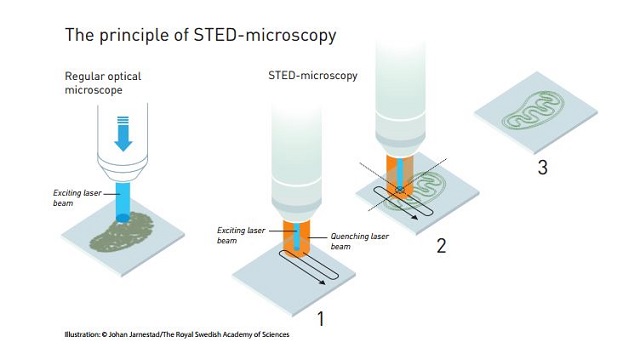
The principle of STED-microscopy. Image credit: www.NobelPrize.org
The Royal Swedish Academy of Sciences has awarded the Nobel Prize in Chemistry for 2014 to the inventors of Super-Resolved Fluorescence Microscopy. The Nobel Laureates are William E. Moerner from Stanford University; Stefan W. Hell from Max Planck Institute for Biophysical Chemistry and German Cancer Research Center; and Eric Betzig from Howard Hughes Medical Institute.
Using fluorescent molecules, the researchers have bypassed the diffraction barrier of conventional optical microscopy. The diffraction barrier restricts optical microscopy obtaining a resolution better than one-half the light wavelength, or 0.2µm, according to microscopist Ernst Abbe. This Nobel-prize winning research has transformed optical microscopy into nanoscopy, enabling the visualization of the pathways of single molecules within living cells.
Nanoscopy allows the visualization of the formation of synapses between neurons in the nervous system, tracking the aggregation of proteins associated with Huntington’s, Alzheimer’s, and Parkinson’s disease, and tracing the division of individual proteins in fertilized eggs into embryos.
The researchers received the Nobel Prize in Chemistry 2014 for two separate breakthrough principles. Using one principle, Stefan Hell developed stimulated emission depletion (STED) microscopy in 2000. This method uses two laser beams, of which one beam illuminates fluorescent molecules and another negates all fluorescence other than from a nano-level volume. Sample scanning on the nanometer scale generates an image having a resolution superior than the limit stipulated by Ernst Abbe.
The results of two separate research works carried out by William Moerner and Eric Betzig laid the cornerstone for the second technique, single-molecule microscopy. The technique is based on the ability to turn on and off the fluorescence of single molecules. Repeated imaging of the same region allows only a few interspersed molecules to glow every time. When these images are superimposed, a dense super-image is generated with a nano-scale resolution. Eric Betzig used this technique for the first time in 2006.
Thanks to this breakthrough achievement, researchers from across the world can gain new scientific insights that are advantageous to mankind.
This follows on from the announcement of the winners of the Nobel Prize for Physics yesterday for the invention of blue LED lights.
The video below is an interview with Sven Lidin, Chairman of the Nobel Committee, discussing why the new microscope that the Nobel Laureates have invented is particularly important and significant to the scientific community.
2014 Nobel Prize in Chemistry: Interview with Sven Lidin, Chairman of the Nobel Committee
2014 Nobel Prize in Chemistry: Interview with Sven Lidin - YouTube - Nobel Prize
Source:
http://www.nobelprize.org